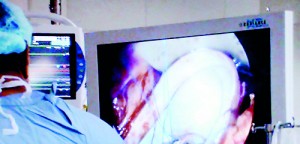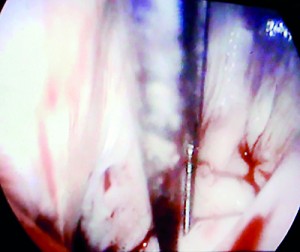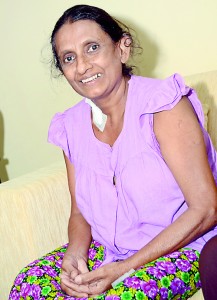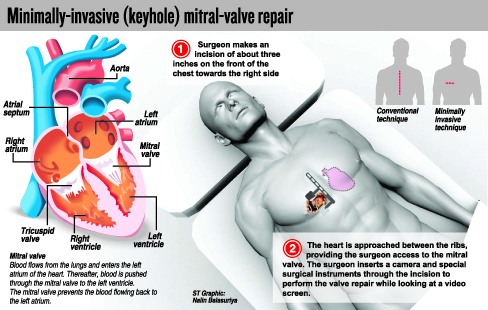News
Keyhole heart surgery at SJGH opens up new vistas
A tiny wave from his beloved Jayawathi dispelled the tension that had gripped W. Lionel as he peered through the glass walls of the Cardiac Intensive Care Unit of the Sri Jayewardenepura General Hospital.

The surgical team at work looking at the video images
Wracked by worry earlier and pacing up and down outside the Operating Theatre (OT), it was only then that he heaved a sigh of relief and sat down for a proper meal.
The wave indicated that his 59-year-old wife was fine after a heart operation but what both he and Jayawathi did not realise was that she was the very first person in Sri Lanka to undergo keyhole or minimally-invasive surgery as opposed to open-heart surgery for a mitral-valve repair. (See graphic)
This trailblazing procedure was performed on September 4.
It was the very demeanour of young and dynamic Consultant Cardiothoracic Surgeon Dr. Rajitha Y. de Silva that had led the couple to Sri Jayewardenepura Hospital having seen

Image of the mitral valve
on a health programme on television the work he was engaging in.
Jayawathi’s heart-trouble had come to the fore last year when they climbed Sri Pada. Although they had been told that there was an amuthu saddayak (peculiar sound) in her chest and she seemed to be suffering from a lot of sema (phlegm), the vomiting accompanied by severe swelling and discomfort in her legs began, after the Sri Pada trek.
Admission to hospital and tests followed and then the strong advice to get it attended to in Colombo. The couple is from Galle.
Now awaiting discharge from the Sri Jayewardenepura Hospital, it is Dr. de Silva who explains to the Sunday Times that Jayawathi was diagnosed with a leak in the mitral valve.

Jayawathi. Pix by M.D. Nissanka
“A lesion in the posterior leaflet of the mitral valve was hindering the adequate flow of blood for her circulation,” he says.
This procedure, however, was different to the pioneering minimally-invasive direct coronary artery bypass (MIDCAB) that Dr. de Silva and his team performed not so long ago in February this year.
As the mitral valve is within the heart, this vital organ would have to be stopped for the repair to take place and its functions transferred to the heart-lung (bypass) machine.
And so it was that having taken Jayawathi to the OT at 10 a.m. on September 4, the keyhole procedure began with an incision in the groin through which the femoral artery followed by the femoral vein were cannulated after which they were linked to the heart-lung machine to keep the circulatory system going. It was a femoral-femoral bypass.
Working in tandem with Dr. de Silva was also Consultant Cardiothoracic Surgeon Dr. Mahendra Munasinghe who had come across from the Lady Ridgeway Hospital for Children and Sri Jayewardenepura Hospital’s surgical, anaesthetic and nursing teams, while the hospital administration headed by Director Dr. S.A.K. Gamage had been fully supportive of the foray into keyhole heart surgery.

Dr. Rajitha Y. de Silva
“Then we made a small incision on the right side of Jayawathi’s chest at the fourth intercostal space (the anatomic space between two ribs), cross-clamped the aorta, infusing cardioplegia (intentional and temporary cessation of cardiac activity or stopping the heart) in a relaxed (diastolic) position,” says Dr. de Silva taking the Sunday Times through the steps of the procedure.
A camera inserted through the incision in the chest then transmitted images of the ‘surgical work area’ onto a screen and it is these images that guided the skilful hands of the two Cardiothoracic Surgeons, it is learnt.
“We looked at the mitral valve and evaluated it, making the decision to go ahead with the repair and not replace it,” explains Dr. de Silva equating a repair as opposed to a replacement, to “winning the lottery”.
To the question why, the answer comes quickly – in a repair there is better long-term survival, better preservation of heart function, lower risk of complications and dispensation of long-term use of blood-thinning medication.
A replacement is like taking one disease out and giving another disease tothe patient, is the view of ‘father of modern mitral-valve repair’ Alain Carpentier, the Sunday Times learns.
Having cut his teeth on minimally-invasive heart surgery with international experts such as Prof. Hugo Vanermen from Belgium and Prof. Jean-Francois Obadia from France, Dr. de Silva is quick to point out the advantages of this procedure against open-heart surgery. It is obviously less-invasive, there is no cutting of bone, there is less pain, faster recovery and the scar cannot be seen.
For Dr. de Silva keyhole heart surgery is “awesome”.
| Heart surgery in Lanka as good as anywhere
“Heart surgery in Sri Lanka has developed in leaps and bounds and now we are on par with any country,” reiterated Consultant Cardiothoracic Surgeon Dr. Mahendra Munasinghe, adding that the country has the expertise and the technology to bring about satisfactory results in a variety of cases. His verdict is that heart surgery has reached a high standard in the five Government cardiac-surgical units at the National Hospital in Colombo, the Kandy and Karapitiya Teaching Hospitals, the Lady Ridgeway Hospital for Children in Colombo and the Sri Jayewardenepura General Hospital. When asked about the mitral-valve repair through keyhole surgery, Consultant Anaesthetist Dr. Kanishka Indraratna said it was a “challenge”, for the patient’s oxygenation and carbon-dioxide removal had to be maintained with one lung as the other had to be collapsed for the procedure. Pointing out that the mitral-valve repair has to be precise, otherwise the team would have had to switch to a valve-replacement, Dr. Indraratna says that under conventional open-heart surgery there is a lot of morbidity and patient outcome is poor. Under keyhole surgery, patient outcome is much better. To monitor heart function and make sure that the mitral-valve repair had gone well, Dr. Indraratna had performed a series of Transoesophageal Echocardiograms (TEEs) throughout the procedure. |

